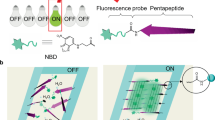Abstract
A novel solid phase organic synthesis resin was synthesized for combinatorial high-throughput screening, which based on FTIR spectra self-encoding functional resin technology. A new deconvolution strategy termed position encoding deconvolution had illustrated and was compared with some popular combinatorial deconvolution strategies in efficiency and information content. The mimic high throughput screening of hexapeptide library successfully, proved the applying of the self-encoding functional resin technology and the position encoding deconvolution strategy.
Similar content being viewed by others
References
Brocchini S. Combinatorial Chemistry and Biomedical Polymer Development.Adv. Drug. Deliv. Rev., 2001, 53: 123–130
Cawse J. Experimental Strategies for Combinatorial and High-Throughput Materials Development.Acc. Chem. Res., 2001, 34: 213–221
McFarland E, Weinberg W. Combinatorial Approaches to Materials Discovery.TIBTech., 1999, 17: 107–115
P Schultz, X Xiang. Combinatorial Approaches to Materials Science.Curr. Opin. Solid State Mat. Sci., 1998, 3: 153–158.
Fenniri H, Ding L H. Barcoded Merrifield Resin Beads.Polymeric Material: Science & Engineering, 2001, 85: 572–573
Pinilla C, Appel J R, Blanc P,et al. Rapid Identification of High Affinity Peptide Ligands Using Positional Scanning Synthetic Peptide Combinatorial Libraries.Biotechniques, 1992, 13: 901–905
Richard A, Clemencia P, Sylvie E,et al. Generation and Use of Synthetic Peptide Combinatorial Libraries for Basic Research and Drug Discovery.Nature, 1991, 354: 84–86
Bing Y, Gnanasambandam K, Harshad A,et al. Infrared Spectrum of a Single Resin Bead for Real-time Monitoring of Solid-phase Reactions.J. Org. chem., 1995, 60: 5736–5738
Zambias R A, Boulton D A, Griffin P R. Microchemical Structural Determination of a Peptide Covalently Bound to a Polymeric Bead by matrix-assisted Laser Desorption Ionization Time-offlight Mass Spectroscopy.Tetrahedron Lett., 1994, 35: 4283–4286
Walter H, Andrè B, Alfred G,et al. Monitoring Solid Phase Synthesis by Infrared Spectroscopic Techniques.Analytica Chimica Acta, 1999, 393: 213–221
Fitch W. Improved Methods for Encoding and Decoding Dialkyl-amine-encoded combinatorial Libraries.J. Comb. Chem., 1999, 1: 188–194
Author information
Authors and Affiliations
Additional information
DU Lei: Born in 1973
Funded by the National High Technology Research and Development Program of China (No 2001AA234071) and the National Natural Science Foundation of China (No. 30200058)
Rights and permissions
About this article
Cite this article
Lei, D., Tong-sheng, C. Self-encoding functional resin applying for combinatorial chemistry and high throughput screening. J. Wuhan Univ. Technol.-Mat. Sci. Edit. 19, 29–32 (2004). https://doi.org/10.1007/BF02835054
Received:
Accepted:
Issue Date:
DOI: https://doi.org/10.1007/BF02835054




